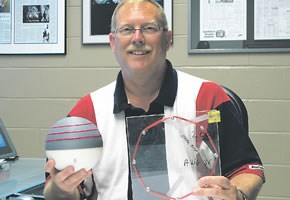
A multi-million dollar research project led by Dr. Greg Baiden, Chief Technology Officer at Sudbury-based Penguin Automated Systems Inc., sounds more like a script for a Hollywood science fiction thriller.In fact, Baiden points to Twister, a film starring Helen Hunt and Bill Paxton, to set the scene for a description of the smart rocks research he is conducting for Rio Tinto.In the 1996 blockbuster, storm chasers risk their lives to introduce glass balls containing temperature, pressure and position sensors into tornadoes to understand how they behave. Smart rocks, approximately the size of a bowling ball, operate on the same general principle, but are being designed for insertion deep inside a rock mass.
Containing sophisticated sensors and communication equipment in a “bulletproof” shell, Baiden’s smart rocks are designed to track the movement of the rock mass in a block cave mine.
 “Rio Tinto came to me a few years ago and said, ‘we have a very significant problem we want to try to solve. We understand empirically how a block cave works, but we don’t understand in scientific detail what’s happening.
What we would like to do is insert a bunch of devices inside of a rock mass that we can track in real time as they move.’
 “I told them this is probably one of the toughest problems I could think of. We can’t use conventional global positioning technology because radio waves from satellites won’t penetrate the rock.”
Block caving is a bulk mining method in which blocks of ore are undercut, causing the ore to break, or cave, under its own weight through drawbells, or funnels, to an extraction level.
It takes between five to 10 years to excavate the drawbells and tunnels before mining can begin, but a block cave mine has the potential to operate for decades as the rock fails all the way up to surface, explained Baiden.
Rio Tinto hopes that the data collected from the smart rocks will shed some light on the size, shape, and spatial configuration of the drawbells to optimize the mining method.
 “Each drawbell can cost between a quarter million to a million dollars and you can have as many as 2,000 or 3,000 draw points,” said Baiden, who is also Canada research chair for robotics and mine automation at Laurentian University.
A better understanding of the process could help Rio Tinto and other mining companies reduce their up-front construction costs and accelerate production.
The idea is to insert the smart rocks into a series of holes drilled into the rock mass.
The gadgetry housed within them will include various sensors, a miniature computer, a transmitter and receiver, an antenna and a clock.
Ultra low frequency radio waves will penetrate the rock and communicate with the smart rocks, but only in one direction – from surface to underground. Another method will be used to collect data from the smart rocks, but Baiden won’t say what it is.
The Laurentian University professor claims block caving is much less expensive than conventional mining methods and could be used by mining companies to exploit the large volume of low-grade reserves in the Sudbury Basin.
“We haven’t embraced block caving in Ontario, but Rio Tinto proved at Massmin 2004 that Palabora rock can be caved and it’s the same strength as Sudbury rock,” said Baiden.
 “Based on my knowledge of the industry and how block caves work, the costs are lower by an order of magnitude.
 “There’s a real philosophical difference between the companies that have been in the business of really making money in the mining industry and the companies that have been borderline.
 “The biggest mining companies in the world - BHP Billiton, Rio Tinto, Codelco and Anglo-American  - are looking at these kinds of methods and that’s why they’re successful.”
The smart rocks technology has the potential to create a significant business in Sudbury if it’s successful, said Baiden.
The Sudbury-based Centre for Excellence in Mining Innovation and the Ontario Centres of Excellence are supporting the research.



